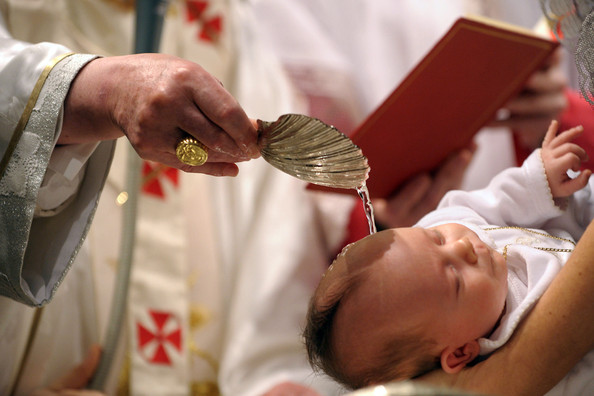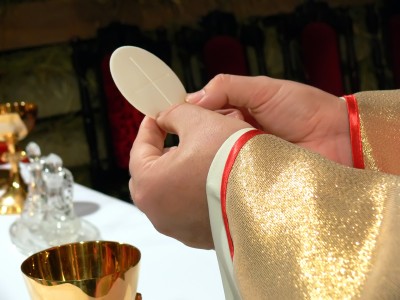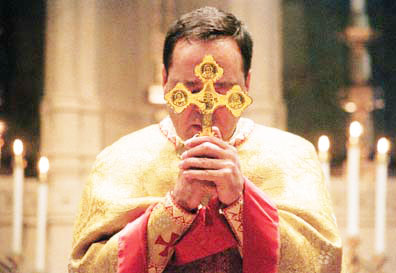Though the Catholic Church does not necessarily
represent a regime of punishment, it does represent a regime of judgment. As
previously stated, the establishment of power by the architecture of a parish and
further differentiation of power among those buildings, as well as among varying
congregations, creates and further cultivates somewhat of a competitive aspect within
the Catholic faith, which then gives way to judgmental tendencies. That is to say the
road to truth is synonymous with one's relationship with God. One can only be in good
standings with God if he or she abides by His law. Thus, he or she who knows, or is
closest to knowing the truth, holds the most power because God becomes that much more
tangible. This power struggle is not only evident among the hierarchy of priests,
bishops and cardinals, but among members of the congregation. Hoover and Coats's
article, The Media and Male Identities: Audience Research in Media, Religion, and
Masculinities highlights the views of "19 Evangelical Protestant men regarding their
ideas about masculinity, media, and religion…" All in all the study noted that the men
not only posited "media as the villain" but further exemplified the masculine
expectations established by their Savior (877).
Thus, through the implementation and continual cultivation of judgment placed
upon believers, parishioners are often times called by their institution to govern
one another in an attempt to abide by what they perceive, of have been told to
perceive as "truth". As it relates to Catholicism, Catholics may be fully cognizant
that God is an omnipresent being and is therefore aware of their actions, therefore
the constant threat of judgment presented by each human believer becomes more of a
reality and thus catalyzes the need for governmentality among one another in
accordance with the beliefs set by the Holy Father. However, while God’s laws may be
intangible, other technologies utilized by the Catholic Church ensure its followers
that God is not only with them, but always watching.
As previously stated, Catholics all of whom are being "watched" by the church, the
saints, each other and above all the spiritual representation of Jesus Christ, brings
Foucault's theory of panopticon to a different light. Because the material aspect of
the representation of fear is removed and instead replaced by the fervent belief that
someone else, someone far larger than they could ever fathom, is in charge, there is
a constant sense of surveillance which gives way to an even greater sense of personal
agency. Thus, through this relatively "invisible" sense of panopticon, in conjunction
with an overwhelming sense of governmentality being imposed upon believers by
believers, the Church's production of "Catholics" via their institutional apparatuses
and technologies provides a vivid illustration of the ways in which an institution
calls its subjects into existence: by formulating practices which are eventually
considered the norm, bestowing an exclusive significance upon the objects and their
symbolism within the church, thus establishing an agreed upon sense of truth which
can then be spread and taught to younger generations as not so much faith, but fact.
Whereas the previous sections explored the power relations established between the
aesthetic components of the church and their respective technologies, along with the
spatial components of places of worship, and their respective technologies, this
section will consider the Holy Sacraments as an apparatus and those methods and tools
which are utilized in order to ensure that the power established by these seven
sacraments are practiced in the everyday life of a devout Catholic. Though there are
seven sacraments within the Catholic faith which are baptism, reconciliation or
confession, communion, confirmation, marriage or holy matrimony, holy orders or
ordination, and the anointing of the sick, also known as the last rites, this
analysis will only focus on three of the seven: baptism, communion, and marriage.
Baptism is the first sacrament to ever occur in the life of a Catholic. More often
than not this celebration, which represents of the rebirth of Christ, takes place when
the child is an infant. During this ceremony the child will usually wear white and is
held over a baptismal font where holy water is poured over his or her head. The
pouring of the holy water symbolically washes away the child's sin and they are reborn
as a child of God. Thus, in this sacrament the primary technologies utilized are that
of the holy water and the baptismal font. Not only are both objects approached and
controlled by the priest, but also are the only means by which a child can become one
of God.

Communion can occur second or third (before or after reconciliation) and symbolizes
the spiritual nourishment provided by Jesus Christ. This moment generally comes when
the child is in the 2nd-4th grade and acknowledges the fact that he or she is headed
toward a life as a mature Catholic. Spiritual nourishment is gained by consumption of
the host, which represents the body of Christ and wine, which symbolizes the blood.
Once again, these technologies are controlled by the priest, therefore ensuring him
with complete control of his parishioners' spiritual nourishment. In Brian Kaylor's
article Sheep Without a Shepherd (but with an Archbishop): Foucault's Pastoral Power
and the Denying of Communion, the author examines the case of Ryan Burke, a bishop in
Wisconsin, who gained a considerable amount of attention upon stating that "he would
deny communion to Democratic presidential candidate John Kerry and other pro-choice
Catholic politicians…" (152). This situation not only vividly exhibits the power of
the Catholic Church and its reservation of their right to deny anyone spiritual
nourishment, but also exemplifies the degree to which one individual can impose and
even more so abuse his power for his own personal benefit and beliefs. This depiction
of the abuse of institutional technologies within an apparatus affirms the ideal that
the Catholic faith calls its patrons into existence with its objects and practices,
and further exposes them to a culture which they must accept in order to remain moral
individuals.

Holy matrimony, or marriage, is the second to last sacrament in which a man and woman give
themselves to one another in a public statement in front of God. It is this loving union
of husband and wife which speaks of the family values present in a holy family. The
primary technologies utilized within this sacrament are rings worn by both the husband and
wife, which symbolize their eternal love for one another. It is often tradition for the
bride to wear white in order to symbolize her maintained purity on her wedding day.

As Foucault states, institutional apparatuses also include those laws or morals which
act as forms of power/knowledge that constitute the institutions. While the Ten
Commandments are considered God's law, the Sacraments present a moral aspect to the
life of a Catholic in the sense that they are key moments in a devout Catholic's
journey. Sacramentum, which in Latin means "sign of the sacred" are special occasions
for experiencing God's saving presence. Thus, language revolving around the Sacraments
presents somewhat of a technology in itself asserting a sense of urgency and vitality
to one's happiness. Pilian asserts, "…language as a cultural concept is not simply
being understood as a 'medium' of a representation of the world, but more importantly
is an inherent part of human thinking, discourse and practice." (1).
Congregation and Audience: Accepting Truth through Practice
|



